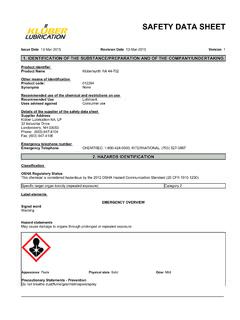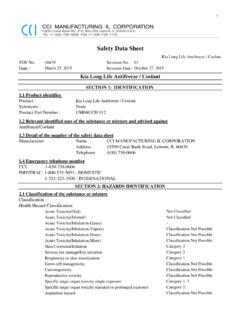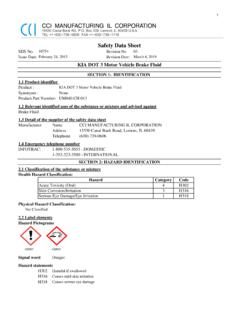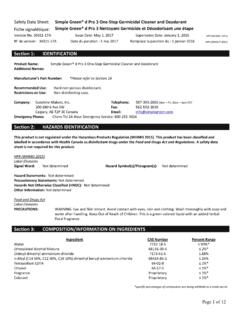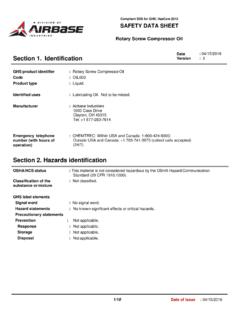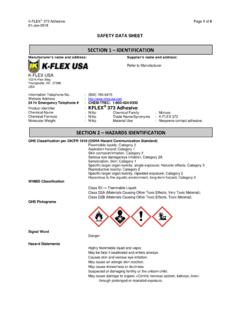Transcription of SECTION 1: IDENTIFICATION - kiachemicals.com
1 Print Date 4/21/2015 Revised 7/06/2018 Page 1 of 5 Product NameValuGard Rust InhibitorOther NamesAnti rust coating, Cavity waxProduct CodeVG-101 UseCorrosion protective coatingCompanyAutomotive International8855 Blue Ash , Ohio 45242 Tel: (513) 489-7883 Fax: (513) 489-1329 Emergency Tel.(800) 262-8200 (CHEMTREC)Physical HazardCombustible liquidCategory 4 Health HazardsSkin corrosion/irritationCategory 2 Serious eye damage/eye irritationCategory 2 Target organ toxicity, repeat exposureCategory 2 Label ElementsSignal WordHazard StatementPrecautionary statementsPreventionDangerCombustible liquid, causes skin irritation, causes serious eye irritation, may cause damage to organs through prolonged or repeated Do not eat, drink or smoke while using this product. Keep away from heat, sparks, open flames, hot surfaces and other ignition sources. Avoid breathing mist, vapours, spray.
2 Wash thoroughly after handling. Wear protective gloves, protective clothing, eye protection, face 2: HAZARD(s) IDENTIFICATIONAUTOMOTIVE INTERNATIOINALSAFETY DATA SHEET (SDS) SECTION 1: IDENTIFICATIONP rint Date 4/21/2015 RevisedPage 2 of 5 ResponseStorageDisposalCanadian WHIMSC lass B Division 3 Combustible liquidMixtureChemical NameCommon NameCAS numberPercent by weightPetroleum DistillatesMineral Spirits64742-88-745%WaxWax, Resin, Viscosity modifiers64742-61-622%General AdviceInhalationSkinEyeIngestionMost important symptoms/effects, acute and Indication of immediate medical attention and special treatment neededTake off immediately all contaminated clothing and wash it before reuse. Wash with plenty of soap and water. If skin irritation or a rash occurs: Get medical cautiously with water for several minutes. Remove contact lenses if present and easy to do and continue rinsing.
3 If eye irritation persists: Get medical SWALLOWED: Rinse mouth. Do NOT induce vomiting. Get Medical advice/attention if you feel eye irritation. Symptoms may include stinging, tearing, redness, swelling and blurred vision. Provide general supportive measures and treat person to fresh air and keep comfortable for breathing. Get Medical attention if you feel ON SKIN (or hair): Take off immediately all contaminated clothing and wash it before reuse. Wash with plenty of soap and IN EYES: Rinse cautiously with water for several minutes. Remove contact lenses if present and easy to do. continue in a dry place. Store in a closed of contents and/or container in accordance with local, regional, state, national, and international 3: COMPOSITION/INFORMATION ON INGREDIENTSSECTION 4: FIRST-AID MEASURESTake off immediately all contaminated clothing. Get Medical advice/attention if you feel unwell.
4 Wash contaminated clothing before + P378: In case of fire; use water spray, carbon dioxide, dry chemical or alcohol foam to extinguish. P332 + P313 : If skin irritation occurs: Get medical attention P337 + P313 : If eye irritation occurs : Get medical advise/attention. P308 + P311 : If exposed or concerned: Call a POISON center/Doctor/Physician. Print Date 4/21/2015 RevisedPage 3 of 5 Suitable Extinguisher type(s)Unsuitable Extinguisher typeSpecific hazardous arising from protective equipment for fire or spill proceduresContainmentCleanupPrecautionsS torageHandlingIncompatible ContaminantsIngredientOSHA PELACGIH TLV-TWAP etroleum Distillate500 ppm100 ppmEngineering ControlsPPEA ppearance FormViscous Liquid ColorTan or amberFlammability Limits (Mineral Spirits) Upper ~6% Lower~ Solvent OdorOdor ThresholdNot DeterminedSECTION 9: PHYSICAL AND CHEMICAL PROPERTIESR espiratory: Level of exposure needs to be determined.
5 If required, use a particulate filter, a NIOSH-approved air purifying respirator with organic vapor cartridge or a supplied air and absorb with inert material. ( oil dry, sand)Dispose in accordance with all local, state and federal the event of a large spill, contain material and recover for use if possible. Avoid discharge into drains, water courses and the 7: HANDLING AND STORAGEKeep away from ignition sources. Keep containers tightly closed. Store in a cool, dry and well ventilated area. Avoid prolonged or repeated skin contact and avoid breathing vapors. Avoid exposure to oxidizing agents. SECTION 8: EXPOSURE CONTROLS/PERSONAL PROTECTIONUse with adequate ventilation. Eye/Face: Face shield, gogglesSkin: Chemical protective all sources of ignition. Provide adequate 5: FIRE-FIGHTING MEASURESC arbon dioxide (CO2), foam, water fog or dry chemical.
6 Do not use stream/jet of water as this will spread material may form explosive mixture with air. Thermal decomposition (burning) will produce oxides of carbon including carbon monoxide and may also produce irritating, corrosive and/or toxic gases, vapors and breathing apparatus and full protective gear must be worn in case of 6: ACCIDENTAL RELEASE MEASURESP rint Date 4/21/2015 RevisedPage 4 of 5 Vapor Pressure at 20 C<3 mm Hg, based on solventpHNot applicableVapor Density (air=1)>1 Evaporation RateNot DeterminedSpecific Gravity, 16 C> Point/RangeNot DeterminedBoiling Point/Range>350 F (>177 C)SolubilityVery slightPartition CoefficientNot DeterminedFlash Point142 F (61 C)CombustibilityClass 4 Auto ignition Temperature> 410 F (>210 C)Decomposition TemperatureNot DeterminedViscosityTime/shear dependentReactivityChemical StabilityStableOther Hazardous ReactionsCombustion PolymerizationWill not occur.
7 Conditions to AvoidStrong oxidizing agents: sources of ignition. Incompatible MaterialsStrong oxidizing agents Decomposition HazardsIngredientLD50LC50 Petroleum DistillatesOral-Rat, > 5gm/Kg4 , > 5500 mg/M3 Routes of ExposureInhalation Ingestion Skin Contact Eye ContactDelayed, Immediate, and Long Term ExposureCarcinogenicitySECTION 10: STABILITY AND REACTIVITYC ombustion products: Oxides of carbon, nitrogen, and sulfur and potentially irritating and/or toxic 11: TOXICOLOGICAL INFORMATIONMay cause damage to organsUnlikely: Expect low ingestion hazard. Do NOT induce skin irritationCauses severe eye irritationProlonged or repeated inhalation of petroleum distillates may cause damage to of the components of this mixture are considered to be a carcinogen by IARC, ACGIH, NTP, OR 12: ECOLOGICAL INFORMATION (non-mandatory)Print Date 4/21/2015 RevisedPage 5 of 5 Eco toxicityEnvironmental FateFor Industrial/Professional Use Only-Keep out of reach of and Canada groundAirfreight and International oceanTSCAAll components are on the TSCA Title III, SECTION 313No, NoneSara Title III, SECTION 311, 312 Fire HazardSECTION 15: REGULATORY INFORMATION (non-mandatory) SECTION 16: OTHER INFORMATIONThe information and recommendations contained herein are based upon data believed to be correct.
8 However, no guarantee or warranty of any kind expressed or implied is made with respect to the information contained material may be harmful to aquatic organisms and may cause long term adverse effects in the aquatic 13: DISPOSAL CONSIDERATIONS (non-mandatory)Hazard characteristic and regulatory waste classification can change with product use. Accordingly, it is the responsibility of the user to determine the proper handling and disposition for disposal according to local, state and federal regulations. (40 CFR 260 through 271) SECTION 14: TRANSPORT INFORMATION (non-mandatory)Combustible liquid, No label required. NFMC#50315 Not regulated for transportNot regulatedThis mixture contains components that are potentially toxic to freshwater and saltwater ecosystems.
